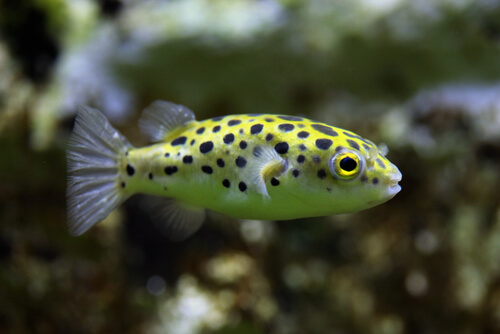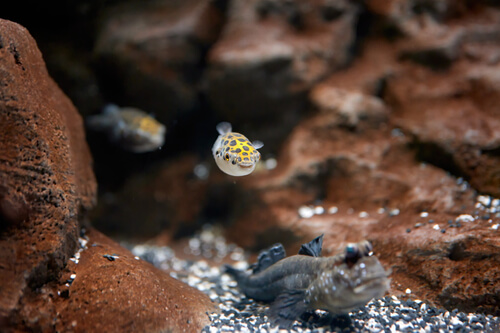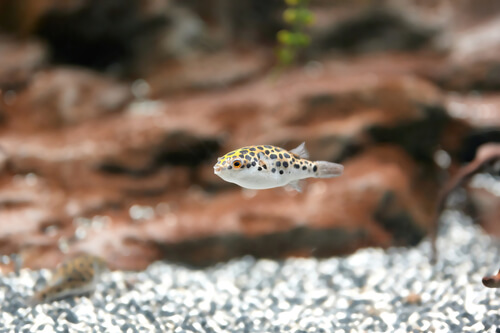Green Spotted Puffer: Care, Size, Tank Mates & More
Posted by on 5/10/2023
We use affiliate links and may receive a small commission on purchases.
Arguably one of the most iconic brackish fish, the Green Spotted Puffer is a fascinating species with a big personality. These pufferfish are a favorite amongst hobbyists for a reason, but those looking to own one should be well-versed in their care before purchasing such a long-lived fish.
In this care guide, we'll provide all the essentials you'll need to determine whether or not the Green Spotted Puffer is the right choice for your aquarium. We'll discuss the fish's unique characteristics, dietary requirements, tank size, and much more.
Species Summary
The Green Spotted Pufferfish (scientific name: Dichotomyctere nigroviridis) is naturally found in the mangroves of Southeast Asia, where it thrives in brackish conditions. The fish's scientific name, nigroviridis, is in reference to the fish's unique green and black coloration.
A known omnivore, the fish primarily feeds off of small crustaceans and invertebrates and can adapt to both saltwater and freshwater environments. Similar to other pufferfish, it's capable of puffing itself up as a defense mechanism, and the species' flesh is known to contain Tetrodotoxin, the same toxin seen in porcupinefish and triggerfish. Luckily, this substance poses no threat to hobbyists, assuming one doesn't decide to eat the fish.

Appearance
Green Spotted Puffers share a similar body type as many of the other popular pufferfish species, such as the Dwarf Pufferfish and Fahaka Pufferfish. The fish features a rounded body, that tapers to a point near the fish's tail fin. The bottom portion of the fish's body is an opaque white, while the top features a green coloration covered in black spots. The fish has rather large lips that form a smile, which can be quite entertaining to look at.
Similar to other puffers, the fish has translucent pectoral, dorsal, and anal fins, and swims in a rather erratic pattern, constantly flapping its pectoral fins and ascending and descending throughout the water column.

Juvenile vs Adult
Juveniles appear similar to their adult counterparts. Juvenile Green Spotted Puffers will share the same coloration and black spots seen on adults, however, they'll be quite a few inches smaller.
Green Spotted Puffers will reach their adult size once they're sexually mature, at around the 5-year mark.
Male vs Female
Hobbyists looking to spot the differences between male and female Green Spotted Puffers should closely examine the intensity of their coloration.
Similar to dwarf pea puffers, male Green Spotted Puffers will showcase more intense colors, and tend to have a more streamlined body compared to their rounder female counterparts.
Size
Green Spotted Pufferfish are on the larger side when compared to other pufferfish species.
Adult Green Spotted Puffers will grow to reach about 7 inches in length. Providing these fish with a well-balanced diet and pristine habitat will encourage the healthiest growth rates.

Green Spotted Puffer Care
The biggest challenge hobbyists will face when caring for a green spotted puffer is maintaining brackish conditions for the duration of this long-lived fish's life.
While juveniles can exist comfortably in freshwater conditions, as these fish mature, they'll require a brackish aquarium. They'll also need to be fed snails and other microcrustaceans to fuel their hungry appetites.
Luckily, the species is well documented and popular amongst hobbyists, so their care requirements are well understood.
🛒 Shop Freshwater Fish on Light Fish
Lifespan
The Green Spotted Puffer is a long-lived species, and when properly cared for, can live for up to 20 years in captivity.
Hobbyists should inquire about the age of the fish before purchasing so that they can plan for the long duration of care required for this unique species.
Tank Size
Green Spotted Puffers are relatively large fish, and we recommend an aquarium that's at least 30 gallons in size for a single puffer.
Hobbyists considering (with caution) additional tank mates should look to an even larger tank, above 50 gallons depending on stocking choices.
Acclimation
Green Spotted Puffers less than 5 years old can be drip acclimated for 30 minutes into a freshwater aquarium, but as these fish age, they'll need to be acclimated to a brackish or marine environment.
When acclimating to brackish or saltwater conditions, you'll need to either drip acclimate them to an established tank with ideal salinity levels (1.026 SG for marine, 1.005 SG for brackish), or you'll need to slowly add salt to the existing freshwater aquarium to reach the target specific gravity levels for a brackish or marine environment.
When transitioning the Green Spotted Puffer from freshwater conditions to marine or brackish, do so over a 2-4 hour period. Monitor the fish for any signs of stress, and adjust the acclimation time accordingly.
Water Conditions
Green Spotted Puffers live in an environment where ocean tides rapidly raise and lower salinity levels. As juveniles, they can live in a freshwater environment, but as adults, they'll prefer a brackish or marine environment.
Hobbyists will want to maintain the following water parameters when housing a Green Spotted Puffer.
Ammonia: 0ppm
Nitrite: < .2ppm
Nitrate: < 10ppm
Specific Gravity (Adult Green Spotted Puffers): 1.005-1.026
Temperature: 74°F-82°F
pH: 8.0-8.1
Tank Setup
Tanks housing a Green Spotted Puffer should have plenty of rock work and should be well-filtered. These fish have a big appetite, and are sensitive to nitrates and ammonia, making a pristine water environment all the more important.
Known to jump, the Green Spotted Puffer requires a tight lid that covers the aquarium, and they'll also require a substrate that maintains alkalinity, such as crushed coral. An adjustable powerhead should be added, to recreate the fast-flowing rivers of their natural habitat.
Plants can be kept in a freshwater aquarium when these fish are young, but once they've transitioned to adults, they'll require a marine or brackish aquarium. Magnolia leaves, java fern, and anubias plants can be maintained in a brackish tank, while marine hobbyists will want to provide plenty of live rock. Ultimately, the aquarium setup will largely depend on whether or not the hobbyist chooses to transition the Green Spotted Puffer to a brackish or marine environment.
🛒 Shop Aquarium Plants Fish on Light Fish
Common Diseases
Due to the different environments that these fish can exist in, Green Spotted Puffers are susceptible to a wide variety of diseases, such as Marine Velvet and Ich, as well as internal parasites.
These fish also need to grind their teeth on hard-shelled foods, such as snails and other crustaceans, and if ignored, can lead to starvation.
Food & Diet
Green Spotted Puffers need to be fed a diet consisting of hard-shelled foods, such as snails, shelled shrimp, mussels, clams, and oysters, 1-2 times per day.
As omnivores, their diet should also be supplemented with nutrient-rich flake foods, as well as frozen foods such as brine shrimp, blood worms, and ghost shrimp.
Due to their requirement for hard-shelled foods, it's not uncommon for hobbyists to establish a dedicated snail breeding tank to sustain their Green Spotted Puffer's diet.
Behavior and Temperament
Green Spotted Puffers are aggressive fish and do best when kept by themselves in an aquarium. Some hobbyists have successfully kept the species with clownfish and gobies such as the yellow watchman and catalina, but pairing the fish with other species can be a risky endeavor.
Temperament varies between individual fish. Diet, tank size, and timing of acclimation can all play into a fish's behavior toward other tank mates.
Outside of their temperament, Green Spotted Puffers demonstrate fascinating behavior. They're highly intelligent and seem to recognize their owners, and they're also quite active, frequently swimming around the center and bottom areas of the water column.
On occasion, hobbyists may even catch these fish puffing themselves up, which typically happens when the species is frightened or threatened.
Reef Compatibility
Hobbyists should proceed with caution when adding a Green Spotted Puffer to a reef tank. While some hobbyists have successfully kept corals, such as chalices and brain corals in a tank housing a Green Spotted Puffer, others have reported their corals being picked at.
If you're willing to risk the health of your corals for a Green Spotted Puffer, keeping the fish well-fed at all times will reduce the chances they'll bother your corals.
Tank Mates
Hobbyists are very limited when it comes to Green Spotted Puffer tank mates. When transitioned to a marine environment, the fish can coexist with other peaceful species, such as gobies, but temperament does vary between individual fish.
Hobbyists should proceed with extreme caution and have backup plans in place in case they notice aggressive behavior.
In a freshwater aquarium, these fish should only be kept in a single-specimen aquarium.
Breeding
Green Spotted Puffers are wild-caught, but in 2009, the University of Florida successfully bred the fish in captivity. .
While there haven't been any successful reports of breeding at the hobbyist level, hopefully, will begin to see captive-bred offerings from some of the larger fish vendors in the near future.
Where to Purchase
Green Spotted Puffers occasionally go up for sale on our marketplace, and do find their way to regional local fish stores.
Hobbyists looking to purchase a Green Spotted Puffer should always inquire about the fish's age and current water conditions so that they can prepare an established freshwater, brackish, or marine aquarium.
Conclusion
It's easy to understand how the Green Spotted Puffer has captivated the minds of hobbyists and scientists. The fish's unique behavior, rumored ability to recognize its owner, and striking appearance makes it a fish worth pursuing, but some will be turned off by the fish's aggressive behavior and dietary requirements.
Now that we've covered the fish in detail, do you plan on purchasing one of these pufferfish? Let us know in the comments, and be sure to check out our marketplace and community forum.
December's Giveaways on Light Fish




















